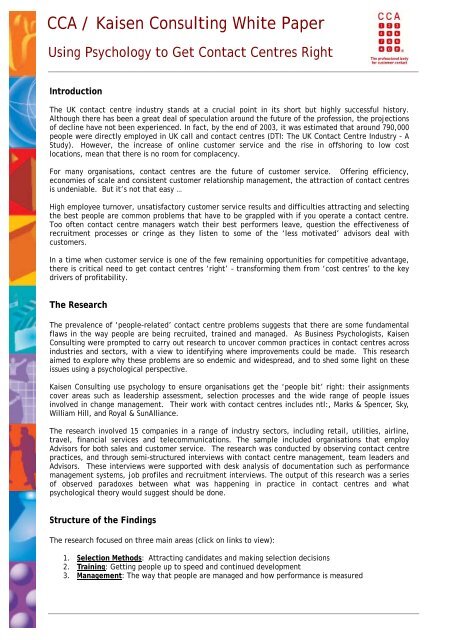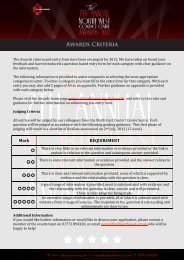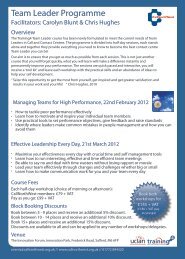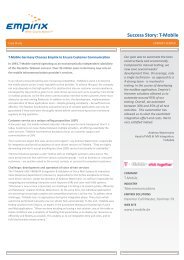Using Psychology to Get Contact Centres Right - CallNorthWest
Using Psychology to Get Contact Centres Right - CallNorthWest
Using Psychology to Get Contact Centres Right - CallNorthWest
You also want an ePaper? Increase the reach of your titles
YUMPU automatically turns print PDFs into web optimized ePapers that Google loves.
Each of these three sections are further divided in<strong>to</strong>:1. Key findings: Common practice in contact centres2. Comments and conclusions: An evaluation and interpretation of what is being done3. Recommendations: Ideas on how things could be done differentlyThis will then be followed with a case study of psychology in action, taking William Hill as an example.Selection MethodsKey FindingsAgencies: Agencies are widely used <strong>to</strong> assist with volume recruitment, largely due <strong>to</strong> the convenience ofusing external support for mass recruitment. However, many companies reported dissatisfaction withagencies; the main complaint being that agencies had limited understanding of the precise needs of theclient, its type of business, strategic goals, working environment and culture. Clients also questionedagencies’ commitment <strong>to</strong> providing high calibre employees. It was commonly observed that manyagencies’ primary motive was <strong>to</strong> receive a placement fee: there was less concern about the quality orsuitability of the employee. Consequently it was unsurprising that several companies had tenserelationships with their agencies.Newspaper Advertising: Adverts in job sections were found <strong>to</strong> generate good candidates, but thevolume was typically low. Regional newspapers were commonly found <strong>to</strong> be the most effective meansof attracting high performing Advisors.Biographical Fac<strong>to</strong>rs: No specific age groups were targeted, however applicants were typically at thelower end of the age spectrum. Education and qualifications were also typically not targeted. Manycompanies reported that they had previously selected on the basis of cus<strong>to</strong>mer service experience, butthere is an increasing trend away from placing relevant experience as a prerequisite.Personal Qualities: Most companies had a set of desired competencies which formed the foundation ofthe assessment process. Typically desired fac<strong>to</strong>rs included:• Communication skills• Self-confidence• Flexibility• Team working• Problem solving• ‘Professionalism’However, many organisations were concerned about whether the profile of competencies they used asthe basis for recruitment resulted in identifying the ‘best candidates’. There was also a lack of clarityabout which qualities were the drivers of trainability and employee motivation.Assessment Methods: The most widely used assessment technique is a structured one-<strong>to</strong>-one interviewbased on the competencies outlined in the candidate specification. Other methods used included:• Scored CVs• Pre-selection questionnaires• Telephone interviews• Group interviews• Typing tests
There was limited use of assessment centres in our sample but, typically, recruitment processescomprised two or three of the above assessment methods.Managing Expectations: Kaisen’s research found that very little is done <strong>to</strong> communicate <strong>to</strong> applicantsabout what the job is really like. The information provided tended <strong>to</strong> emphasise the positive aspects ofthe role, such as variety, team work, bonuses, with little said about the emotionally draining, demotivatingor frustrating aspects of the role.Comments and ConclusionsAgencies: The use of agencies was most successful when the client organisation was highly specificabout what they were looking for. In addition, many organisations reported that close moni<strong>to</strong>ring ofservice levels from agencies was critical <strong>to</strong> a successful relationship. In particular, it was found thatwhen clients complained or gave specific feedback, service levels improved. If you are going <strong>to</strong> use anagency, the most effective approach is <strong>to</strong> establish a long-term relationship. In-plants, partnerships andpreferred supplier relationships were highlighted as steps <strong>to</strong>wards using agencies effectively.Newspaper Advertising: The ‘ideal candidate’ descriptions in the advertisements were typically overspecifiedin terms of previous experience required, thereby reducing the pool of potential candidatesand possibly ruling out good people.Biographical Fac<strong>to</strong>rs & Personal Qualities: The ‘competencies’ sought were very general, with mostbeing the kind of qualities you would want <strong>to</strong> find in any employee in any job. It is therefore difficult <strong>to</strong>see how they distinguish between candidates who are suitable for the Advisor role and those who arenot. There also appear <strong>to</strong> be a number of surprising omissions from the candidate specifications. Theseinclude:• Specific motivation for contact centre work: Psychological research shows that ‘motivationalfit’ is key <strong>to</strong> high performance and retention. Moreover, the unusual nature of the contactcentre Advisor role requires a very specific ‘motive profile’. The omission of motivation fromthe candidate specifications may go a long way <strong>to</strong> explaining the high levels of attrition found inmany contact centres.• ‘Multi-tasking’: A typical Advisor is required <strong>to</strong> operate a computer, problem solve and hold aconversation with the cus<strong>to</strong>mer simultaneously. This represents one ‘multi-tasking’ aptitude,not three separate skills. It is commonly observed that those Advisors with a strong ability inthis area are able <strong>to</strong> serve the cus<strong>to</strong>mer more efficiently and avoid the ‘pregnant pauses’ oftenheard in conversations with less skilled Advisors.• Empathy: Highly effective Advisors have the ‘emotional intelligence’ <strong>to</strong> identify with thecus<strong>to</strong>mers by building a ‘mental image’ of the person. This ‘mental image’, which oftenincludes things like the appearance, lifestyle and personality of the individual, enables theAdvisor <strong>to</strong> treat the cus<strong>to</strong>mer as a person, rather than just a disembodied voice.• Emotional resilience: Key <strong>to</strong> success in the Advisor role is the ability <strong>to</strong> cope effectively withthe emotional ‘downsides’ of the job, particularly cus<strong>to</strong>mer complaints and frequent rejectionon sales calls.Assessment Methods: Organisations take a wide variety of different approaches <strong>to</strong> assessing candidates.However, assessment methods used do not always measure the fac<strong>to</strong>rs they are intended <strong>to</strong> measure.For example, several organisations used group exercises <strong>to</strong> assess social confidence. However,confidence in dealing with others face-<strong>to</strong>-face may not translate in<strong>to</strong> confidence in telephoneconversations.The validity of some of the assessment methods used is doubtful, therefore the organisation is exposed<strong>to</strong> risks in relation <strong>to</strong> discrimination and recruiting unsuitable people. In some cases it was difficult <strong>to</strong>see how the capabilities measured in the exercises related <strong>to</strong> the demands of the job.
The assessment of candidates’ performance on the exercises was often based on very complicated andambiguous rating scales. These scales were open <strong>to</strong> different interpretations and therefore left theprocess open <strong>to</strong> high levels of subjectivity and bias.The competency-based face-<strong>to</strong>-face and telephone interviews used tended <strong>to</strong> focus on past behaviourand not future potential. Therefore there is a risk of ruling out potentially effective Advisors who havenot had the opportunity <strong>to</strong> demonstrate their capabilities fully. This is especially pertinent when oneconsiders the high levels of competition when trying <strong>to</strong> attract Advisors.The methods used did not always appear <strong>to</strong> be cost effective. For example, many organisations usedcomplex interview-based procedures which assessed around 10 different competencies. Due <strong>to</strong> thecomplexity of the procedure, a substantial investment in training was required <strong>to</strong> achieve high interraterreliability.Managing Expectations: Psychological research has shown that job satisfaction and retention arerelated <strong>to</strong> the impression of the job people form during the recruitment process: i.e. the more realisticthe view of the job an individual has before they join, the more job satisfaction they report and thelonger they stay. The tendency <strong>to</strong> ‘talk-up’ the job can result in candidates’ expectations beingviolated and contribute <strong>to</strong> low job satisfaction and a higher risk of quitting.RecommendationsKaisen has the following suggestions for improving selection methods following their research:• ‘Cast the net far and wide’: The recruitment process should attract a wide range of applicantsand select people on the basis of capability, not experience.• Manage agencies carefully: When working with agencies, they should be provided with a verytight brief and the quality of service and candidates supplied should be moni<strong>to</strong>red closely.• Use a ‘staged’ recruitment process: To increase the likelihood of identifying candidates withthe ‘right stuff’, the recruitment process should stimulate a large volume of applications andincorporate a number of stages <strong>to</strong> ‘filter’ candidates. Use of screening questionnaires is a useful<strong>to</strong>ol for ruling out unsuitable candidates at an early stage.• Assess core skills: The assessment process should be focused on those fundamental qualitieswhich underpin effective job performance but which are difficult for people <strong>to</strong> develop, such asempathy, motivation and emotional resilience. It is much easier <strong>to</strong> train people in systems andselling techniques than <strong>to</strong> train them <strong>to</strong> empathise with cus<strong>to</strong>mers.• Look for ‘contact centre qualities’: Select people on the basis of the personal qualities whichspecifically predict contact centre success. In particular, assessing candidates’ ‘motivationalfit’ with the Advisor role and contact centre environment is critical <strong>to</strong> identifying highperforming employees.• Use work sampling: <strong>Using</strong> assessment methods which simulate the psychological demands ofthe job will increase the accuracy, objectivity and fairness of recruitment decisions. Forexample, use role-play exercises where candidates need <strong>to</strong> perform a task while talking <strong>to</strong> acus<strong>to</strong>mer <strong>to</strong> assess the ability <strong>to</strong> empathise with cus<strong>to</strong>mers and ‘multi-task’.
• Build in validation: Measures should be taken <strong>to</strong> record data on the recruitment process. Thisdata can then be analysed <strong>to</strong> ensure the validity and fairness of the process and also identifyareas for improvement.• Manage candidate expectations: Ensure that there is a specific part of the recruitment processdesigned <strong>to</strong> make sure that candidates understand what the job is really like – ‘warts and all’.For example, include a realistic ‘day in the life’ video or a discussion with an existing Advisor.TrainingKey FindingsInduction Programmes: These varied from two <strong>to</strong> six weeks in duration, depending on the complexity ofthe IT systems and products. Most of the training was ‘classroom-based’, involving group tuition andcomputer-based training. A smaller proportion of time was spent outlining cus<strong>to</strong>mer service and salesskills. These sessions were predominantly focused on models and theories, with limited opportunitiesfor individual practice and feedback.Training Design: The typical approach was <strong>to</strong> break training down in<strong>to</strong> modular form. For example,training was provided separately on using the telephone, operating the system, learning about products,cus<strong>to</strong>mer service etc. Employees were typically tested at the end of each module <strong>to</strong> ensure that theymet the required standard of ‘know how’.Comments and ConclusionsLack of focus on ‘critical soft skills’: Training is given a high priority but the focus is technical. It is,however, the soft skills that are recognised <strong>to</strong> ‘make the difference’. Making the cus<strong>to</strong>mer feel caredfor has a significantly higher impact on cus<strong>to</strong>mer satisfaction than an Advisor’s level of adherence <strong>to</strong> setprocedures. The focus of training is thus disproportionate.Limited opportunity for practise: Unlike product and system knowledge, complex behavioural skillssuch as empathy, the ability <strong>to</strong> tailor communications <strong>to</strong> different types of people cannot be effectivelydeveloped through classroom teaching. These emotional skills are only developed through repeatedpractice and feedback over an extended period of time.Overly segmented training design: Modular training does not recognise that skills have <strong>to</strong> beintegrated, such as talking on the telephone while processing data and using the system. When theselearning processes are not put <strong>to</strong>gether, this can lead <strong>to</strong> errors on the job, especially when faced with adifficult cus<strong>to</strong>mer. The result is de-motivating, and there is an increase in the time needed for recoverywhen a call goes wrong. People may also perform well on each of the separate units of the training, butare unable <strong>to</strong> perform them simultaneously.RecommendationsUse integrated training methods: Training should be holistic, that is, developing all of the call handlingskills simultaneously. The most effective approach is <strong>to</strong> begin with a simple scenario which requires theindividual <strong>to</strong> talk <strong>to</strong> the cus<strong>to</strong>mer, use product information and operate the system at the same time.Then <strong>to</strong> ‘layer on’ the complexity of cus<strong>to</strong>mer, product and system as the employee develops theirconfidence and competence.
Focus on developing ‘soft skills’: There needs <strong>to</strong> be more training in cus<strong>to</strong>mer service and sales skills.Repeated opportunities <strong>to</strong> practice these skills in role-play and real situations and receive in-depthindividual feedback will develop these essential capabilities more efficiently.Build in ongoing evaluation: There is a need <strong>to</strong> track performance improvements and developmentsrather than just ‘doing and assuming’.ManagementKey FindingsUse of IT: Information Technology is an integral aspect of contact centres. This has resulted in a vastarray of information being readily available on Advisors, for example the duration and number of calls,‘wrap up’ time etc. Team Leaders typically spend a lot of time compiling Advisor profile statistics <strong>to</strong>give regular feedback.Numerical targets: With this type of information, the tendency is <strong>to</strong> set a multitude of numericaltargets which are closely moni<strong>to</strong>red and regularly reviewed.Motivation: There are a large variety of initiatives designed <strong>to</strong> increase motivation, some of which arevery imaginative. They include schemes such as nights out, ‘theme days’ e.g. World Cup or Wimbledon,awards and bonuses. But generally, Team Leaders lack the skills <strong>to</strong> motivate people. Instead theirfocus is on administration and allocating.Comments and ConclusionsTechnology: The more sophisticated the IT, the greater the focus on numbers rather than the people.Despite the Team Leader role being seen <strong>to</strong> be about coaching and developing, the reality is thatmanagers spend the vast majority of their time compiling and analysing management information.Therefore team leaders tend <strong>to</strong> focus on giving feedback but not helping individuals know, practically,what <strong>to</strong> do with it.Numerical Targets: People who have multiple targets generally feel that they are being watched andmoni<strong>to</strong>red continuously. Understandably, highly specified performance targets can be constraining andde-motivating. Conversely, development and recognition results in higher morale and lower attrition.Focus on Process: The focus was <strong>to</strong>o strongly on activity rather than output; i.e. what Advisors weredoing rather than what they were achieving. Not only does this impact on Advisors’ feelings of jobcontrol and au<strong>to</strong>nomy, it can have a damaging effect on cus<strong>to</strong>mer service. For example, in severalcompanies there were instances of Advisors purposefully disconnecting cus<strong>to</strong>mers mid-conversation inorder <strong>to</strong> reduce their average call duration scores. Clearly a performance management process thatreinforces such behaviour will have a profoundly negative effect on cus<strong>to</strong>mer satisfaction and retention.Motivation: Motivational events can result in a short-term uplift in morale, but the effect is short-livedbecause they do not satisfy people’s deeper motivational needs, such as the need for recognition andneed for achievement. Effort would be better spent developing Team Leaders’ ability <strong>to</strong> ‘tune in’ andrespond <strong>to</strong> people’s underlying concerns.
RecommendationsSelect team leaders carefully: Assessing potential Team Leaders’ inner motivation and corepsychological skills will give a strong indication of their fit for the role. Team Leaders must have amotivation <strong>to</strong> want <strong>to</strong> help others <strong>to</strong> develop and <strong>to</strong> make their area of the business successful. Inaddition, they need the communication, thinking and emotional skills <strong>to</strong> put that motivation in<strong>to</strong> actioneffectively. Also, remember, great contact centre Advisors do not necessarily make good Team Leaders,the two roles need distinctly different profiles of motivation and skills.Use the ‘coach concept’ for the role: The Team Leader role needs <strong>to</strong> be revised. A greater emphasis isneeded on coaching and development, as opposed <strong>to</strong> checking and administration.Don’t over-control with performance measures: There is a temptation <strong>to</strong> measure everything, which isconstraining on Advisors and Team Leaders. Focus on key outputs and pick a few key things. Enablepeople – tell them what you need from them and give them the freedom <strong>to</strong> act. This will help them <strong>to</strong>develop.<strong>Psychology</strong> in Action: Case Study of William HillAs well as being a major player in the traditional betting arena, William Hill has been expanding in<strong>to</strong>new markets in recent years. Alongside its more traditional high street ‘shops’, the company isdelivering its services <strong>to</strong> new cus<strong>to</strong>mers who prefer <strong>to</strong> place bets via the telephone and internet. Andthe demand <strong>to</strong> bet on a much wider range activities – not just the traditional horse racing – has placedincreased pressures on those charged with taking bets swiftly, accurately and with courtesy. At first,these pressures <strong>to</strong>ok their <strong>to</strong>ll. William Hill’s contact centre churn peaked at 130% per year. Withconservative estimates of the cost of recruiting and training at £1500 per head, the business decided <strong>to</strong>take the issue very seriously. There appeared <strong>to</strong> be three main reasons for the high ‘churn’ rate:• Unsociable hours: most sporting events, and therefore most bets, take place at weekends. Noteveryone was suited <strong>to</strong> working these times.• The unusual and potentially stressful nature of the work: there were massive peaks andtroughs in the work cycle: long periods of ‘down-time’ followed by highly intensive, pressurisedwork. For example, at peak times, the centres were handling over 640 calls simultaneously. OnGrand National Day, the contact centres handled over 100,000 calls! It seemed that those whoenjoyed the pressure hated the quiet periods; those who preferred a steadier workflow weredisconcerted with the sudden bursts of frenetic activity.• Competition: the increasing development of contact centre businesses in the region meant thatthe market for good people was very competitive.Clearly things had <strong>to</strong> change. As David Russell, Group HR Direc<strong>to</strong>r describes, “Initially, we tackled thisissue internally and, by refining our existing recruitment procedures, we had some success; cuttingturnover by around 30 per cent. However, we soon realised that, <strong>to</strong> achieve and maintain a significantreduction, we had <strong>to</strong> take a more innovative and challenging approach <strong>to</strong> how we selected staff.”William Hill needed an edge which would keep it ahead of the pack. It looked <strong>to</strong> psychology <strong>to</strong> raise thestakes.“Realising that the psychology of people is what makes the difference, we needed <strong>to</strong> think harder aboutthe make-up of the people we wanted, how best <strong>to</strong> bring them in<strong>to</strong> the business and how we could keepthem motivated.” says David.Working with Kaisen, William Hill used psychology in a number of ways:
• Diagnosing: getting ‘under the skin’ of what was going wrong and working out what we needed<strong>to</strong> do• Attracting: appealing <strong>to</strong> people who are genuinely motivated for the job• Pre-screening: quickly and fairly filtering out people who are not right• Recruiting: selecting people who will ‘live the brand’ and want <strong>to</strong> stayAs David outlines, measuring motivation was an important missing piece of the recruitment jigsaw.“Our procedures were appropriate in terms of identifying people who could do the job – those who couldcommunicate well with our cus<strong>to</strong>mers and process their bets efficiently. But what we needed weremore subtle investigative techniques which would also enable us <strong>to</strong> determine an individual’s‘stickability’: whether someone would be happy, over the long term, <strong>to</strong> work in this distinctenvironment.”Psychological research shows that motivational ‘fit’ is key <strong>to</strong> high performance and retention. Thisapplies <strong>to</strong> all contact centre selection, but it was particularly important in William Hill’s case. Theyneeded people who wouldn’t just cope with the peaks and troughs in workflow but positively enjoy it.Psychologists would typically expect those who get a ‘buzz’ from the fast pace of peak times <strong>to</strong> feelbored or even guilty when the pace is much slower. In this case, however, William Hill requires peoplewho respond positively <strong>to</strong> both the ups and downs in the workload cycle – enjoying the busy times andthe quiet times.Research in<strong>to</strong> the ideal contact centre employee revealed another motivational dilemma. The peoplewho were right for job also had <strong>to</strong> be ‘competitive’ in a non-competitive environment. Many contactcentres are sales-driven, with staff being encouraged <strong>to</strong> compete with each other. This didn’t apply <strong>to</strong>William Hill’s Leeds and Sheffield operations, but staff still needed <strong>to</strong> have an internal sense ofcompetition. The business needs <strong>to</strong> recruit people who are happy <strong>to</strong> take on a challenge for its ownsake; <strong>to</strong> compete with themselves <strong>to</strong> do the best job they could and get every call right for the client.Recruitment ProcessThe revised candidate specification formed the basis of a new recruitment process <strong>to</strong> attract and selectpeople with the right core psychological skills and motivation for the job.AdvertisingScreening Interview: Basic CriteriaOpen DayMain Assessment :Motivation Interview & Cus<strong>to</strong>mer Service ExerciseAdvertising: Adverts in the local press were designed <strong>to</strong> attract people whose motivational profile fittedwith the job.Screening Interview: The initial telephone screening focused on two areas: eligibility (over 18 yearsold, valid National Insurance number or work permit), and availability – the need for them <strong>to</strong> fit in<strong>to</strong>available shifts and work at weekends. Those who met the criteria were invited <strong>to</strong> an open day.Open Day: This involved a <strong>to</strong>ur of the contact centre, and then a ‘warts and all’ briefing about the job.The objective was <strong>to</strong> manage candidates’ expectations and <strong>to</strong> help them decide for themselves whether
they would enjoy the work and be good at it. They also under<strong>to</strong>ok a numerical judgement exercise,which looked at their ability <strong>to</strong> perform basic numerical calculations.Main Assessment: The final stage of the assessment process involved candidates being invited back <strong>to</strong>the contact centre <strong>to</strong> take part in a short assessment centre. This involved two activities:• Motivation Interview: This looked at motivational fit in more depth and assessed candidates’ability <strong>to</strong> cope with the specific emotional demands of the job. The assessment drew on thedetailed linguistic assessment, in that candidates were assessed on how they answered aquestion as well as what they said.• Cus<strong>to</strong>mer Service Exercise: This exercise was a work sample activity, which stimulated thepsychological demands of the job. Candidates <strong>to</strong>ok part in a series of short role-plays wherethey had <strong>to</strong> take bets from three very different types of cus<strong>to</strong>mer. The exercise assessedcandidates ability <strong>to</strong> multi-task i.e. talk <strong>to</strong> cus<strong>to</strong>mers whilst problem solving and using a system,and tailor the way they spoke <strong>to</strong> different types of cus<strong>to</strong>mers.Business ImpactPsychological profiling has enabled William Hill <strong>to</strong> ‘cast its net’ far wider in search of good people.Candidates don’t necessarily need <strong>to</strong> know anything about betting or working in contact centres; ifthey’ve got the core psychological skills and want <strong>to</strong> learn, they’re half way there: William Hill’straining programme will give them all the operational skills they need.As David Russell explains, “Recruiting people with the right stuff rather than the right experience is aradical departure from the usual approach <strong>to</strong> contact centre recruitment, but we’re confident that itwill effect a significant reduction in staff turnover. This, in turn, will secure direct commercial benefitsfor William Hill by reducing the considerable expenditure involved in recruitment and training.”There have been many positive results from the endeavour. Most notably, there has been a substantialdrop in attrition - from 106% <strong>to</strong> 67% - which has made a significant reduction of the costs of running thecentres. There has been positive feedback from assessors; they feel that the process has removedsubjectivity from recruitment and, as a result, they feel more confident making judgements and givingfeedback <strong>to</strong> candidates. The recruitment process has also received positive reports from candidatesthemselves, particularly in relation <strong>to</strong> the process’ ability <strong>to</strong> give people a ‘feel for the job’. Finally,the rigour of the process has served <strong>to</strong> raise the profile of William Hill in the employment market.Overall ConclusionsThere are many challenges facing the contact centre industry. Notwithstanding the huge costs of labourturnover resulting from high attrition (up <strong>to</strong> 180% a year!), there are concerns around contact centreAdvisors’ abilities <strong>to</strong> meet cus<strong>to</strong>mer service targets and hit sales ratios. Some organisations have sought<strong>to</strong> solve the problems by moving contact centre locations abroad. However, in many cases this hasmerely lead <strong>to</strong> a series of different, but equally challenging, problems. Surely the best solution forcompanies, cus<strong>to</strong>mers and the UK contact centre industry is <strong>to</strong> get UK contact centres ‘right’.Kaisen’s research has shown that psychology can transform contact centres: by helping <strong>to</strong> identify theright candidates and, crucially, encouraging them <strong>to</strong> stay.In areas such as selection, contact centres currently have poorly defined selection criteria. What isneeded is a move <strong>to</strong>wards recruiting the ‘right stuff’, not the right experience. Potential recruits shouldbe given a realistic picture of the role <strong>to</strong> avoid misleading recruits about the nature of the job. Training
should cover the full range of skills needed in the job in an integrated way. Finally, Team Leaders need<strong>to</strong> be just that: individuals who have a genuine desire <strong>to</strong> lead and develop their people.Classic contact centre problems, such as high employee attrition, have been evident ever since contactcentres began. The inclination therefore could be <strong>to</strong> accept these problems as ‘the way things work’.Kaisen’s research, and the success of organisations such as William Hill, has shown that there areabundant opportunities <strong>to</strong> not only make contact centres less costly <strong>to</strong> manage and administer, but alsotransform them in<strong>to</strong> profit centres.This fact sheet was provided by:Kaisen Consulting LtdBusiness PsychologistsWeb: www.kaisen.co.ukEmail: link@kaisen.co.ukTel: 0117 925 5533






